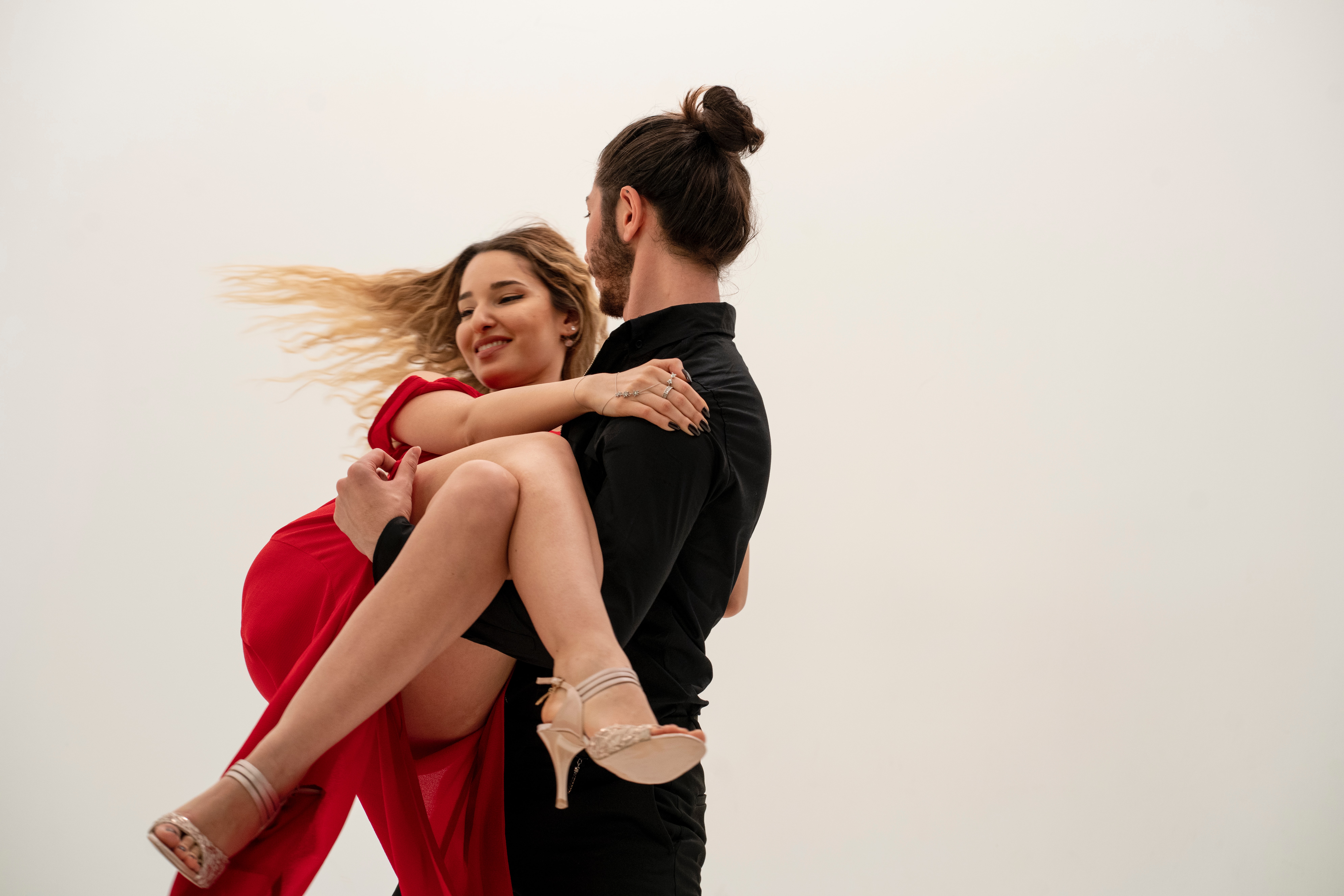Every night a woman is out social dancing, she will remember exactly one guy. She’ll think about him—briefly—on her way home. “That was one of a kind,” she’ll say to herself, hoping that he will be around next time.
Who is that man? Don’t you want to know how he did it?
I know you do, and I will tell you all about him. But before we learn how to become a great salsa leader, I will share how I figured out what women really want.

When you start dancing salsa, you don’t really think about this: you always dance with another person.
For most men, that’s pretty scary. It makes you feel pressured. If you suck, your partner does not really enjoy herself–at least not for more than one song. If you lead her badly, she can’t really dance. If you step on her foot, it hurts her foot–but it also hurts your ego.
You would think that saying sorry after failing a move makes it right. You’re WRONG.
Women in dance classes are always nice. ,,Oh, it’s okay,” she’ll say, “accidents like that happen.” Then she shuffles on to the next leader. If he’s a better dancer, you can tell. She’ll be excited to finally dance with that guy.
Wouldn’t you prefer it to be slightly different? After you finish the dance, she sighs. Her eyes are shining a little bit more. She gives you a knowing smile that tells you that was great.
That would be something, wouldn’t it–Making her happy like that! What if you could consistently facilitate that kind of bliss in the girl you dance with?
When I started dancing salsa, I nervously paid attention to the reactions of my dance partner. I’m quite empathetic. I felt stressed whenever I noticed that my leading confused her. And since I noticed my follower’s negative reactions (many men don’t), I apologised a lot. “Oh, sorry I lead you that way,” I would say. ”Shit, that was off. Next time!”
Then I noticed something crazy, and this will be your first lesson to become a great leader. Whenever I apologised, it seemed to make it worse.
I could see her state drop a little. An almost inaudible sigh of annoyance would escape her lips.
You would think that saying sorry after failing a move makes it right. You’re WRONG. In fact, if you’re a beginner, it often makes it worse.
1. Stop Apologising
Caveat for autistic leaders and creepy dudes: ALWAYS apologise when you actually do something wrong. If you spit in her face while talking, knock her out with a spinning elbow, or accidentally touch her boob, apologise immediately. Unless, of course, the boob-accident seems to make her suddenly extremely interested in you—JOKE!—joke, okay?—just apologise. Also, stop being creepy.
Your job in a couple’s dance is to lead. You know what a leader does? A leader leads to the best of his abilities.
The point is, apologise when it’s necessary. But don’t apologise for every step you take. Don’t apologise for being in that class. Don’t apologise for existing. If you are a beginner in salsa, every second step will be a mistake. That’s ads up to a lot of apologies.
The fact that you do that means that you’re a great guy. You think about your surroundings. That is a lot better than being obnoxious. But it messes with your dancing game.

I understand you have the impulse to say sorry all the time. You want her to know that you know that you fucked up. You think that improves the situation. It doesn’t. It makes the situation worse, and here is why:
Your job in a couple’s dance is to lead. You know what a leader does? A leader leads (obviously)—to the best of his abilities. Good leading is valuable, bad leading is less valuable. A guy who stumbles over his feet AND keeps commenting on his inadequacies has no value to offer.
Now, don’t just skip over this part, please. This is a lesson that every man needs to learn—not only when it comes to dancing! I repeat: a guy who stumbles over his feet AND keeps commenting on his inadequacies has no value to offer.
If you suck at something, that’s fine. But you need to own it. Owning it means to shut up and focus on making it better. Owning it means to make yourself vulnerable by being yourself and accepting that you suck. Instead of covering up your mistakes with words, you focus on the process.
If you suck at something, that’s fine. But you need to own it.

I’m sorry about what’s about to follow, but here is no better metaphor. Let’s imagine you’re a 30-year-old virgin.
Finally, you are being intimate with a girl who really likes you, and even better, she already knows you’re a virgin. (It’s the same in a salsa-class. She already knows that you have no idea what you’re doing: you’re in a class to learn salsa.)
Accepting Vulnerability Leads to Confidence
But back to our fantasy scenario. Let’s say it is finally about to happen. So how to you make this first experience less terrible?
Even though you’re a virgin, you ought to be somewhat smooth. So what are you going to do?
Are you going to be like “Oh, sorry—not there?—this is my first time, you know” and then continue throughout the whole thing saying stuff like “Oh, shit, I did it again” and “Fuck, I’m so sorry I am a virgin. I promise next time I won’t be a virgin anymore”—You will be, if you keep going like that.
In dance, it’s the same thing. You can’t change you skill-level over night. But you can change your attitude.
Be yourself, accept that you suck in the beginning (she already knows), and do your best.
Here is the magic formula that will change your journey forever: Instead of saying sorry all the time, ask her questions.
Your follower is another human, remember? That means you can get feedback from after your dance (or perhaps even in the middle).
The Magic Formula
- “How was it?”
- ”Was my signal here clear enough?”
- ”Do I need to lift my arm higher?”
There’s two sides to it. On the one hand you just need to be quiet and accept that you need more practice.
On the other hand you need to learn to ask for honest feedback, say sorry only when you did something really stupid, and get on with it.
Understand that when you are a leader, you receive the gift of trust. Don’t squander it by acting more confused than you already are.
When I stopped being apologetic, my dances immediately became a lot better. My followers relaxed. If the leader is tense, the follower can’t be NOT tense. (And what is being apologetic if not tenses?)
Suddenly the girls I danced with seemed to have more fun, and I could tell that they enjoyed my company a lot more.
- Women hate apologetic men (not men, who apologise when appropriate).
- Followers (in dance or elsewhere) hate indecisive leaders.
Understand that when you are a leader, you receive the gift of trust. Don’t squander it by acting more confused than you already are.
To summarise your first lesson to become a better leader: lead to the best of your ability without being overly apologetic.
2. Provide a Smooth Experience
As a leader, your only job is providing a smooth experience to your follower.
Being a follower in dance is about letting go; it’s about not having to think about what move comes next.
Following allows her to be completely present and focus only on the music. Your role as a leader is to make this experience possible.

Everything you do that blocks the follower from getting into “the zone” is bad. If you step on her foot, that surely stops her from letting go completely. So does being constantly nervous around her.
It’s natural to be nervous. It’s human. But it’s much better if you just do your best and focus on making her experience better instead.
As a leader, your only job is providing a smooth experience to your follower.
To speak in terms of polarity: the masculine in all of us provides direction, the feminine provides energy. If there are no (or shitty) directions, there’s no safe space for the feminine to shine. (If what I’m telling you here sounds either confusing or interesting, read David Deida).
If your lead in salsa isn’t clear, her experience is bumpy, even unpleasant. The dance becomes the opposite of smooth.
Because you’re not doing your job properly, she has to step in and think about what is happening. She has to take on some of your responsibility. It’s inherently unpleasant for her. It robs the dance of that which is most valuable to the follower.
In the beginning it’s difficult to focus on her experience. There are just too many things to think about. If you struggle with this, read on.
3. Be Clean
Be hygienic. This should be somewhat obvious, but I’m sure followers will appreciate it if I make sure to include this point in this article.

What does it mean to be hygienic?
- Wear a fresh shirt
- Come to class showered
- Wear deodorant
- Brush your teeth (and don’t forget to floss)
- Bring another shirt just in case
- Stock up on gum and mint
- Cut your fingernails
- Don’t cough around
- Wash your hands before class
- Don’t eat spicy food before
- Don’t touch your face between dances (that’s for your own sake).
Got it? Great, let’s move on.
4. Become a Sensitive Guy
I know men are usually told to be tough. But don’t you worry: if you were a tough manly man, you probably wouldn’t read articles about pleasing women though dance. So let’s just drop the ego.
Practice becoming more sensitive. Dancing is intimate. It requires patience, sensitivity, and empathy.

What Sensitivity is
Practice becoming more sensitive. Dancing is intimate. It requires patience, sensitivity, and empathy. If you currently don’t have these things, you better start learning them immediately. Being sensitive means that you adapt to your partner’s body, mood, and energy.
Most dancers (and that includes many women) have a difficult time doing that. They simply confront their partner without taking a second to really consider the person in front of them. This type of obnoxious behaviour isn’t only limited to the word of salsa dancing.
They are physically and emotionally rough, grab hands too hard, stare at the other person in a manner that is inappropriate for their current level of intimacy. Not only is a lack of sensitivity the biggest cause of bad leading, it’s also a turn-off (to psychologically healthy women).
Especially if you go dancing to meet women, you better make sure you’re not acting like a brute.
How to Develop Dance-Empathy
To become more sensitive, you need to learn to focus on the person in front of you.
When you dance in a couple, it’s not about you. It’s not about her either. The dance is about the connection between you.
Sensitivity is not a function of time. You don’t automatically get it after dancing a given number of years. Sensitivity is about insight.
Nevertheless, if you want to achieve the best possible experience for both of you, you make the dance about her. Focus on her and she will allow for a great connection to happen. It’s a gift from her to you; a gift that requires trust. If you focus only on yourself going through the motions, she doesn’t really become involved, hence there is no connection.
Sensitivity is not a function of time. You don’t automatically get it after dancing a given number of years. Sensitivity is about insight.
Do you understand what this means? It means you can literally suck as a leader even if you have taken classes for a long time. Yes, really.
If you don’t have insight, you might be a pain to dance with—and you don’t even know it! I see these insensitive leaders all the time. They’re mostly older, and have learned to dance salsa under a rock. When they dance with a follower, she will feel mistreated, manhandled, or simply annoyed—unless she also lacks sensitivity, which is not uncommon.
The insight you need is the ability to feel what’s going on in front of you, really look at your follower—notice what mood they are in.
If you’re good at this—I kid you not—you can learn more about a person by dancing with them than you could in an hour of conversation. You’ll see their fears, their positive sides, their trauma. And that, my friend, is when dancing really begins.
5. Learn to Follow
Depending on how long you’ve been dancing, you probably have heard that following is great practice for leaders. That’s because when you follow yourself, you get a better sense of the signals that the follower relies on. If you’ve never followed before, you have no idea what good leading is like.
When you go back to being a leader after having followed, you will know how important it is that the leader knows what the follower is doing at any given moment.
This, again, does not only apply to dancing. Imagine you take a job at the army, but you get immediately promoted from civilian to sergeant major.

Do you think you would be a good leader even though you skipped fifteen years of career ladder?
Do you think you would be a good boss to your subordinates if you have never experienced being a subordinate to good as well as bad leaders?
I doubt it. You probably wouldn’t have the slightest cue how to lead.
Learning to follow drastically improves your chances of becoming a great salsa leader. You get to experience her perspective first hand. You’ll find out how annoying it is when you’re being pulled, roughly, in the wrong direction. You’ll learn to how it feels if you don’t know what the other person wants you to do, yet stares at you expectantly.
Being a follower every now and then will also allow you to experience what it’s like to dance without having to think about what to do. You will find out how nice it is to just relax and go with a lead. You understand what gift it can be to “just” follow.
Learning to follow drastically improves your chances of becoming a great salsa leader.
As a result, you’ll get better at taking responsibility for the dance you share with your followers. Perhaps, you will even develop a deep understanding for what your role as a leader entails; how to keep her in flow.
When I started learning Cuban salsa, I started going to beginner classes that were below my level and danced as a follower there.
You don’t have to do this forever, but I really recommend you to try it, especially in the beginning.
6. Think for Two
When you go back to being a leader after having followed, you will know how important it is that the leader knows what the follower is doing at any given moment. You anticipate the signal she needs to receive—before she does.
- As the leader, you need to know not only what move you will do next.
- You also need to make sure that she knows (on time), what move you will perform.
- And then, of course, you also need to complete the move.
So really you have to think about three things: preparing the move, preparing her for the move, and then executing the move.
For the time of the dance, you’re her guardian.
Thinking for two means you are aware of what foot your follower is on at all times.
Ideally, you don’t only know what foot she should be on (according to the beat), but also what foot she is actually on. (These aren’t always the same, especially if you dance with a beginner or when you just did something confusing.)
Of course, paying attention to her is extremely difficult when you can barely keep track of your own feet. (More about how to become better at that later on.)
The Worst Case Scenario
The reason you have to think for her, too, is this: let’s say for some reason she is on the wrong foot when you want to make the move you prepared. If you force the turn, it will become messy.
Here is what will happen to you if you ignore the advice in this article:
She stumbles, grabs ahold of your shoulder, your phone slips out of your pocket, shatters on the floor, you slip on the pieces of broken glass, and since you’re trying to keep yourself (and your follower, who has grabbed you by the arm) from following, you reach for the most stable-looking thing in your proximity.
It’s the DJs table. As you reach out, you only manage to grab the table cloth. You fall on top of your bewildered follower—ripping the DJ’s 4000-Euro-Mac-Book Pro and the equipment of the table.
The huge speakers, attached to the computer by a cable, start to fall over, hitting clueless dancers in the head.
Everyone is screaming—then there’s silence.
You ripped out the cable.
Everyone is looking at you in horror.
Now, do you see why it is important to know what your follower is doing at all times?

For the time of the dance, you’re her guardian.
This means protecting her from unpleasant sensations such as turning when she is just regaining her balance (first time social dancing with high-heels!). If she bounces into other people, it’s probably your fault—although some followers move through space like a horse with blinders on, no doubt.
Nevertheless, a sought-after leader assumes responsibility for her steps, rhythm, and position in space.
If you do all these things successfully, and she still stumbles all over the place and doesn’t follow your lead, a raised eyebrows directed at her (ideally only one) might improve the situation.
Now the next question, of course, is how to develop the ability to not only be aware of your own body, but of the body of another person.
The answer is practice.
7. Dance as Much as Possible
When I started dancing salsa, I didn’t go to parties for the first six months. I was too scared. “Once I learned enough in class,” I thought, “I will be ready to social dance.”
Makes sense, right? It might. But it’s the wrong approach.
From day one of your life as a dancer, you want to overcome the fear of going out to salsa parties. You need to dance with as many women as possible.
Rip of the Bandage NOW
You will suck either way. You will suck if you go out dancing after your first dance class. And you will also suck if you go out dancing six months after taking your first dance class.
From day one of your life as a dancer, you want to overcome the fear of going out to salsa parties. You need to dance with as many women as possible.

The Difference Between Dancing Salsa in Class and Social Dancing
If you postpone the challenge, you will build up expectations about how followers will react. These expectations will be build on the girls in your class.
When you did A, they always did B! Of course they did. They knew what move was coming. They helped you lead them.
The difference is that when you’re social dancing, girls don’t tell you what to do. They expect you to know.
It doesn’t really matter how many classes you take before you go social dancing for the first time. Your first night out you will feel like a loser any way.
That’s why I suggest getting it over with quickly.
Get Out of Your Bubble
If you don’t, you will be like one of these delusional martial arts masters, who truly believe they are unbeatable. They live in some remote village, and have never tried to fight anybody. If you match them up with a 19-year-old half-decent MMA fighter, they get to face reality—the hard way.
Dancing is like that in a sense.
You can stay in your bubble and imagine that you’re improving, or you can find out how good you really are on the dance floor. If you are committed to become a better leader, there is, unfortunately, no other way for you to reach your goal than to do that which feels uncomfortable.
Understand that you could become a great leader without every taking a single dance-class. You could simply go out social dancing; observe, copy, fail, and repeat. Cubans do it that way.
You would probably agree that Cubans seem pretty good at Cuban salsa.
8. Understand the Music
We could consider music to be a feminine form of expression. It’s closely tied to emotion. Music is the product of emotion, but also the cause of it.
Women are usually better at perceiving, interpreting, and communicating emotion than men. So naturally, women will be better at men when it comes to understanding, experiencing, and feeling the music.

This is a great advantage. But on the dance floor, her insight is the cause of ther suffering.
Imagine you’re a chef, and you know exactly how long to fry our omelette. But in the decisive moment, somebody grabs and restrains your hands. You are forced to watch your eggs burn.
When a follower who understands the music is led by a guy who doesn’t, it sucks. Since she is following, she cannot help but go with whatever the leader “makes” her do. If your moves don’t match the music, she is forced to dance in an unnatural way.
Just think of this: If she was dancing by herself right now, she would almost enjoy herself more—at least she would be able to be in tune with the music.
If you do not move to the music, therefore, you force her into your miserable lack of musicality upon her.
How to Get To The Climax
On the other hand, if you understand the structure and the story of the song, you can take her on an energetic journey.
You will be able to lead her through highs and lows, from a slow romantic mood to playfulness, to a bit of a flirt, and finally, to an exhilarating climax (a musical climax!—Jeez, what’s wrong with you, man?)
If you manage to do that, she’ll give you “the smile” after you’re done.
And she will be happy to dance with you again in the future, and if you did really well, maybe even marry you!
Dancing Salsa is Like Going On a Date
I always tell my students that leading a salsa song is like going on a date.
It starts slow, you get to know each other. You’re careful, and you slowly begin to share yourself with the other person. Step by step, you’re opening up your energy.
Only after a while does it become more intense (or not—if you two don’t match).

Depending on development of your date, ramp up the energy and become more playful. You wouldn’t go for the make-out before asking for her name, would you?
To understand music, you need to watch what advanced dancers are doing, take musicality classes, listen to as much music as possible, and once again, work on becoming more sensitive to the world. In couple’s dance, sensitivity equals skill. Only if you’re aware of your own experience; how your emotions ebb and flow with the music, can you reach your full potential as a salsa leader.
9. Lead Softly
Many salsa dancers lead way too hard. And many salsa followers follow only if they’re being led hard. ,,Too hard for what,” you may wonder.
It’s too hard to provide the most pleasant and sensible experience for both dancers.
Be clear in your leading, but lead softly.

- A good rule of thumb (pun intended) that you never want to close your fingers around her hands when you lead. Rather, your hands are to remain as open and almost flat as possible at all times.
- Lead with minimal force and energy—just enough for her to feel that here is a signal. The follower is supposed to move independently, even spin independently in most turns. Your lead is meant to provide signals, not stability.
- The leaders and the followers’ hands are glued together by invisible tension or pressure.
- There’s no holding ever—unless you lead your follower though space in Paseala. However, in that case you usually grab the entire wrist.
- Not only does holding hands feel uncomfortable for followers, it also makes turning more difficult, and even increases the risk of injury.
Be clear in your leading, but lead softly.
If you can be sure that your lead is on point and your follower does something else, it’s her fault. This idea about how “it’s always the leader’s fault,” ceases to be true once you know what you’re doing.
If you are a good leader, you don’t have to lead harder just because she isn’t following. It’s unpleasant and causes a vicious cycle: followers become habituated to follow only when it’s rough enough.
If she doesn’t follow your lead, don’t sweat it. Let her mess up, look at her and smile.
If it happens often enough, she will start to adapt—which will ultimately make her a better follower.
10. How to Ask for a Dance
There’s a lot of talk about asking for dances. Probably that’s because most men are terrified of getting rejected.
If you follow all of the steps I have outlined in this article, you should soon be a pleasure to dance with. If that’s the case, you don’t have to worry about how to ask a woman to dance.
Just hold out your hand and wait for her to put her inside. Smile.

As long as you are still a beginner, you want to be more careful in your approach. You suck at dancing, so you want to make sure she can decline without making things awkward.
Asking: ,,Do you want to dance?” (I know, it’s crazy!) will be your best bet in that case.
Make room for her to say no if she thinks that the dance will suck. A song is pretty long. If you’re stuck with a woman who would much rather dance with the next guy, it will feel like an hour.
If you know what you’re doing, you already know the follower, and you know she will be happy to dance with you, just grab her hand (Again: autistic and creepy leaders are excluded from that rule.)
If you know you’re good, asking women to dance becomes less of a hassle. You will be able to wait for them to ask you to dance instead.
11. First things first: Competence
Almost everything we talked about in this article requires attention. You can only pay attention if you have free mental space.

Your brain is like a hard disk.
If you’re running a bunch software at once, additional programmes will barely open (especially if you’re on Windows).
As long as you’re still busy keeping the beat and avoiding to bump into other dancers, it will difficult to focus on the nuances of good leading and following.
How to Get Good at Salsa Fast
Once you stick to the rhythm effortlessly, never end up on the wrong foot, understand the music, and know how to deal with a large variety of moves, it will be a lot easier to focus on your partner.
Only if you don’t consciously have to think about your own body, can you fully focus on your partner’s energy, movement, and needs.
Competence is the result of
- taking a lot of classes with a good teacher (which isn’t always the same as a good dancer),
- watching videos of dancers you admire,
- going out social dancing as much as possible,
- and perhaps even taking private lessons.
I have personally taken more than 300 private lessons in salsa when I started out, and I recommend that you take private lessons to get personal feedback.
Anytime you dance, you become more competent.
But if your technique is off, you might turn your mistakes into a pattern. Do this long enough and you’ll be stuck with your mistakes forever.
It’s the truth; I see it all the time. People who dance in a bubble (like a small town or a specific school which teaches weird things), are stuck with their early misinformation forever.
Becoming a great leader is a process that requires time and attention. Be patient with yourself. But remember that it lies in your power to make it happen.

